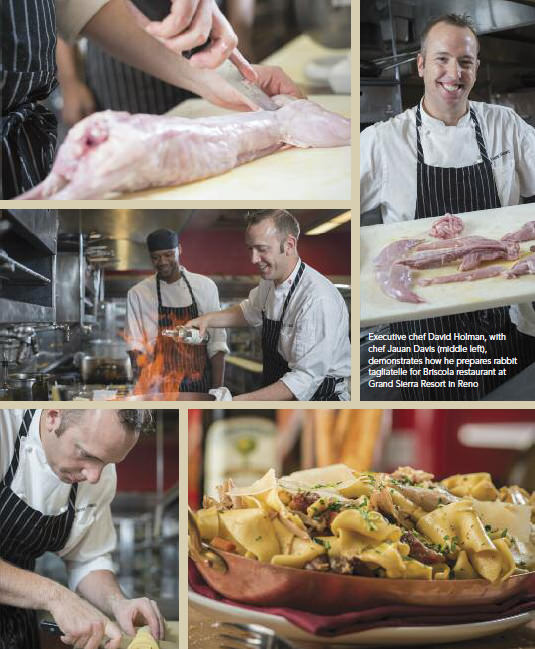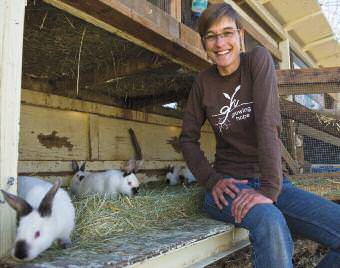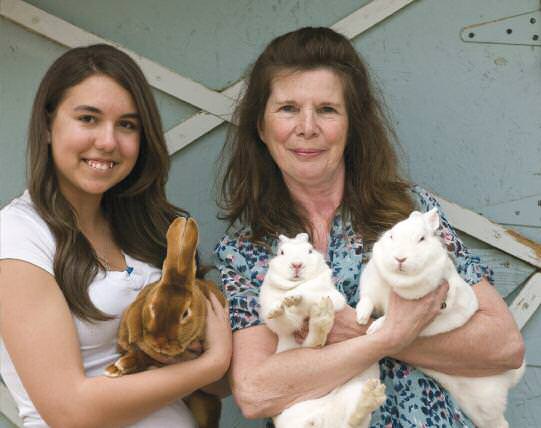edible notables
A HARE-RAISING EXPERIENCE
Keeping meat rabbits presents some challenges.
WRITTEN BY BARBARA TWITCHELL
PHOTOS BY CANDICE NYANDO (RABBIT RECIPE PHOTO BY CHRIS HOLLOMAN)
Blame it on the Easter Bunny. Thumper probably didn’t help either.
Susan Rogers has been fighting those iconic images for years. Rogers is the longtime leader of Bouncing Bunnies in Carson City, a 4-H group dedicated to raising rabbits. And not only bunnies for show, mind you. We’re also talking about for dinner.
When it comes to rabbits, the cuteness factor definitely gets in the way. Rogers contends that it is a major reason why rabbits aren’t common items in our grocery stores or on our plates. That’s unfortunate, Rogers believes, and many health experts, environmentalists, and food aficionados strongly agree.
Rabbit is highly regarded as one of the healthiest meats available. Pound for pound, rabbit meat has significantly more protein and less fat than just about any other meat and is virtually cholesterol free.
Add to that great taste. Young, domesticated rabbit has a light, delicate flavor, similar to chicken but firmer. Chefs love it because it essentially is a blank canvas that readily accepts any flavors you cook with it.
And rabbits multiply, well, like rabbits, and require few resources, making them a highly sustainable food source. What could be better?
Hopping Hurdles
For more than 15 years, Rogers has been teaching 4-Hers how to breed and raise meat rabbits.
Together, they challenged Nevada Junior Livestock Show organizers and, after a five-year struggle, succeeded in getting meat rabbits officially recognized as livestock this year. Reversing the 75-year-old NJLS policy was no small feat. Rogers hopes it’s a significant step toward changing public perception about rabbit meat.
Another challenge has been on Rogers’ radar: unraveling the perplexing regulatory status for commercially sold rabbit meat. Rabbits are exempt from USDA regulation; inspection is voluntary. But there has been much confusion about what state and local regulations may apply, and the costs these processing standards would incur for any potential commercial processor. As a result, no facility managers in Nevada were willing to commercially process rabbits until recently.
This created problems for local breeders who wished to sell their meat to restaurants and the public, forcing many of them out of business. It also made it difficult for Rogers’ 4-H kids to market their project animals.
Many in the food industry agree that the Nevada laws regarding rabbit processing need to be changed to be more supportive of independent breeders in the state. There is a light on the horizon, however. Thanks to the efforts of Mike and Terri Marsh of Rise & Shine Farms in Fallon, their facility recently became the first state-approved processing plant for rabbits, opening the door to commercial sale of local rabbits. (As an aside, Rise & Shine became Nevada’s first legal chicken processor in 2012.)

No Rabbit Tricks
Melissa Russell, 15, has been coming to Rogers’ 4-H group since age 3, as a tagalong to her older siblings. She raised her first show rabbit at age 5 and moved up to meat rabbits at 9 because they offered greater challenges.
That includes actually getting to breed the animals, which makes the rabbit project different among 4-H programs. These youngsters are required to learn about breed characteristics, genetics, mating, gestation, and birth processes, as well as care and nutrition of the animals. They literally are involved in every part of the animal’s life cycle.
So isn’t it difficult for the kids to raise these cute, furry, little bunnies, knowing that they are destined for someone’s dinner plate? Rogers says that she prepares them for this from the start, as all 4-H leaders do.
“They name them things like Breakfast, Lunch, and Dinner or Bar, Be, and Cue. It’s a daily reminder to them that these are not pets. But yes,” Rogers adds, “every year there are tears. It’s going to happen. But it’s that way with any of the animals.”
“It was hard the first year,” Melissa says, “but it doesn’t really bother me much anymore. You learn not to get too attached.”
Still, Melissa admits that she has never tasted rabbit and probably never will. Then again, she also doesn’t eat lamb or veal.
Blame it on that cuteness factor.
Reno writer Barbara Twitchell learned a great deal about rabbits while researching this article, enough to know that rabbits and hares, while related, are not the same. Still, she offers no apology for the title. After all, how could she resist such a great pun?
More Information
Backyard Bunnies
Logical Livestock for City Ranchers
A strong advocate of healthy, sustainable, locally sourced food, landscape architect Jana Vanderhaar grows lots of it herself — vegetables, eggs, even meat. That may not seem surprising until you learn that she lives on a scant one-third of an acre, smack in the middle of Reno.
Four years ago, Vanderhaar decided to expand her backyard mini-farm to include some kind of livestock. Cows and pigs seemed impractical, given the location and this city girl’s limited experience. But then she learned about meat rabbits. The animals are clean, quiet, small, and inexpensive. They consume relatively little, require minimal space and care, reproduce rapidly, and have tasty, lean, and healthy meat. She was sold.

Using books and Internet resources, she taught herself all she needed to know to successfully breed and raise the rabbits. She even learned the butchering process by watching YouTube videos.
Vanderhaar bought an old farm trailer that she converted to a rabbit hutch. Then she purchased two does and one buck as her breeders. Being rabbits, in no time there were many more. And the good thing about the kits in those litters is that they grow quickly. Within two or three months, they are ready to go.
“It’s something that you can easily raise in your backyard,” Vanderhaar says. “It doesn’t take much in the way of resources to raise these animals. They’re very easy.”
Yielding an average of six kits a litter, five times a year, her two does produce about 60 rabbits annually. That’s more than enough for her family of three, with plenty to share with friends.
Not too bad for a city girl on a third of an acre.
RECIPES
Rabbit Tagliatelle
(courtesy of David Holman, executive chef, Charlie Palmer Steak at the Grand Sierra Resort in Reno. Serves 4)
Ragout
1 rabbit, legs and tenderloins
½ cup carrot, diced small
½ cup celery, diced small
1 cup onion, diced small
4 cups chicken stock
½ bunch thyme
4 sprigs rosemary
1 head garlic, peeled and left whole
½ cup Dijon mustard
1 cup white wine
Olive oil
Salt and pepper, to taste
1 tablespoon chopped fresh parsley
1 teaspoon chopped fresh thyme
1 teaspoon chopped fresh marjoram
4 tablespoons butter
Pecorino Romano cheese, to taste
Preheat oven to 300 degrees F.
Season the rabbit pieces with salt and pepper. Heat a drizzle of olive oil in a Dutch oven and brown rabbit, one layer at a time, in the pan, careful not to crowd the meat. Be sure to use enough olive oil so as not to burn the bottom of the pan. When rabbit is browned on both sides, remove to a separate plate.
Drain all fat from the pan. Add carrots, celery, onion, garlic, and thyme and rosemary sprigs, and sauté until slightly caramelized in the bottom of the pan. Deglaze pan with white wine, taking care to scrape the browned bits off the bottom, infusing the liquid with the rabbit drippings.
Add rabbit back to the pan. Cover with chicken stock and Dijon mustard; it should be just enough to cover rabbit. Bring to a boil. Cover and place in the oven. Cook for 1½ hours, until rabbit is tender.
Remove pan from oven, and allow to cool to room temperature. Pull rabbit pieces from liquid, remove bones, and add the meat back to the braising liquid.
Tagliatelle Pasta
1 dry quart (1.3 pounds) Tipo “00” pizza flour (If necessary, all-purpose flour will suffice)
1 tablespoon extra-virgin olive oil
1 cup water, if needed
1 tablespoon salt
4 eggs
6 egg yolks
Using a stand mixer, combine flour, salt, and olive oil. Add eggs and egg yolks one at a time. When incorporated, allow to rest in the bowl for 10 minutes, in order for the flour to be fully saturated.
Turn mixer on, and work pasta dough in the machine for 30 minutes on medium setting. This will help to develop gluten in the pasta and hydrate it fully, which enables you to be able to roll it out into long, thin ribbons.
Remove dough from mixer, shape into a ball, and wrap with plastic wrap. Allow it to sit at room temperature for two hours. (It can be refrigerated and made into pasta the next day.)
Unwrap dough, and roll out until extremely thin, turning on a floured surface. The dough should be rolled thinly enough to make pasta ribbons that are 12 to 18 inches long. Cut tagliatelle pasta with a sharp knife.
Boil pasta in salted water, about 1 tablespoon of salt per quart of water. Boil for three to four minutes, until almost done, slightly chewy, and a tad undercooked.
Remove pasta from water and add it to the braising liquid in the Dutch oven, along with 4 tablespoons of butter, and finish pasta in the liquid to absorb flavors and thicken sauce. Sprinkle with herbs and fresh Pecorino Romano before serving.
Rabbit Stew
(courtesy of Barb Giacomini, chef/owner of Daughters Café in Reno. Serves 6)
This recipe was inspired by memorable winter meals on a fabulous trip to France.
2 rabbits (whole or in pieces)
1 stick butter
3 teaspoons salt
1 teaspoon pepper
4 tablespoons flour
4 cups beef broth
4 cups white wine (Riesling, if you have it)
1 pound bacon
2 yellow onions, diced
6 garlic cloves, minced
1 pound shiitake mushrooms, sliced
2 cups cream
Box quick polenta
Handful Parmesan
Melt butter and make a roux with flour, salt, and pepper. Stir in the broth and wine.
Add the rabbit to the broth. Add broth and wine to cover rabbit, if necessary.
Bring to a boil, cover, and reduce heat. Slowly simmer for one hour, or until meat is falling from bone.
Remove meat to a cutting board and cool; debone and shred (or chop). Add meat back into the stewpot.
Chop the bacon into small bits and brown well (dark and crispy) in a large frying pan. Add the onions and sauté until golden. Add the garlic and mushrooms, and sauté until tender, about five minutes.
Add this mixture to the stewpot (use a rubber spatula to get all of the good stuff out of the pan) and slowly simmer for another 20 minutes.
Follow the polenta directions, but use half milk and half water. Add a handful of grated Parmesan per serving to the polenta when it is finished but still hot.
To serve, fill half of a shallow bowl with polenta and ladle rabbit stew over it to fill the bowl.
Resources
Rise & Shine Farms
6166 Lakeview Drive, Fallon
775-867-5605
http://www.Riseandshinefarms.com
Retail sales of locally grown rabbit meat by the only state-approved processing facility. Will also process rabbits for independent breeders and general public.
Sierra Meat & Seafood Co.
1330 Capital Blvd.. Ste. A, Reno
775-322-4073
http://www.Sierrameat.com
Wholesale and retail sales of rabbit meat from small, Midwest farms. Call ahead or order online. Small orders require customer pick-up.
Silver Desert Rabbitry
Reno
775-742-7461
http://www.Silverdesertrabbitry.webs.com
Sells meat rabbits as foundation stock for breeding meat producers.
Susan Rogers, 4-H leader
Bouncing Bunnies, Carson City
775-450-2812
Sells meat rabbits as foundation stock for breeding meat producers.
Whole Foods Market
6139 S. Virginia St., Reno
775-852-8023 (ask for meat department), http://www.wholefoodsmarket.com/stores/reno
Retail sales of rabbit meat from Midwest farms. Call first to confirm item is available.
Devil’s Gulch Ranch
Nicasio, Calif.
415-662-1099
Wholesale and retail rabbit meat sales from California breeders. Will ship to restaurants or individuals.


